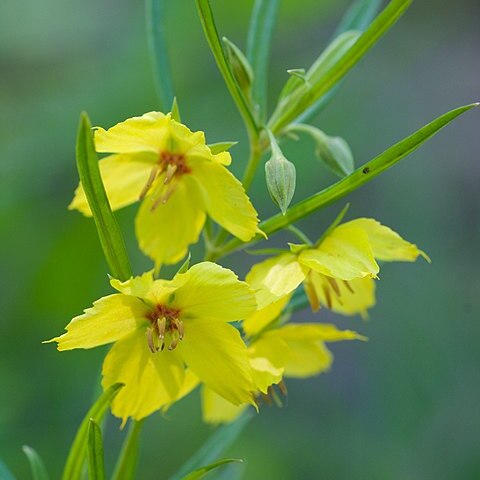Stems erect, simple or branched, (1.2-)2-10 dm, glabrous; rhizomes slender; bulblets absent. Leaves opposite; petiole 0.1-0.5(-0.9) cm, ciliate at very base near nodes, cilia 0.1-0.8 mm; blade linear to narrowly lanceolate, 3.4-9 × 0.2-0.6 cm, base cuneate, decurrent, margins entire, revolute, eciliolate, apex acute to obtuse, surfaces not punctate, glabrous; venation single-veined or obscurely pinnate. Inflorescences axillary in distal leaves, solitary flowers (or verticils). Pedicels 0.5-2.8 cm, glabrous. Flowers: sepals 5, calyx not streaked, 3.5-6 mm, glabrous, lobes lanceolate, margins thickened; petals 5, corolla yellow, sparsely streaked with brownish-violet (sometimes obscure) resin canals, rotate, 7-13 mm, lobes with margins entire (sometimes slightly erose distally), glabrous, apex apiculate, stipitate-glandular adaxially; filaments weakly connate at very base, shorter than corolla; staminodes 0.6-0.9 mm. Capsules 3.5-5 mm, not punctate, glabrous (rarely sparsely stipitate-glandular). 2n = 34.
More
Erect, 3–10 dm from a short rhizome, usually with short branches from the upper nodes; lvs firm, usually ascending, linear, 3–8 cm × 2–7 mm, gradually tapering to the sessile base, the margins smooth and revolute or with a few cilia at the very base, the lateral veins obscure or obsolete; fls almost entirely in terminal clusters on the stem and branches; cal-lobes lanceolate, 4–6 mm; cor-lobes 7–12 × 5–9 mm; stamens distinct; staminodes triangular to subulate; 2n=34. Moist or wet soil, especially on prairies; Mass. to Ga., w. to Man. and Ark., chiefly n. of the Ohio R. and w. of the Appalachians, and in the Ozark region of Mo. July, Aug. (Steironema q.)

